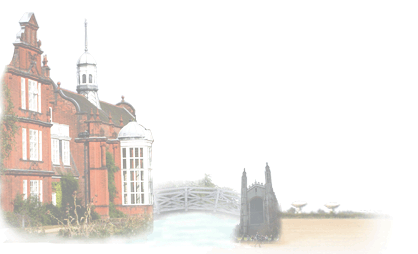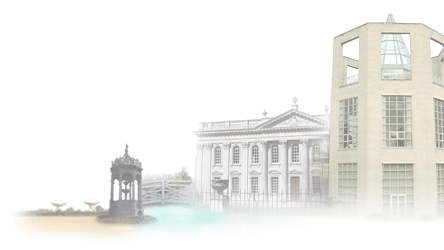
A
Cambridge perspective
on the digital world
August 2005
TV changes direction
With digital households in Britain now in the majority, television – and radio too – is going through its biggest change since the first flickering broadcasts in black and white. Within five years, more people could be watching TV over broadband Internet than by tuning in to a conventional analogue channel. How will this change the way TV works? Will people still bother to watch TV channels, when there is so much else available on demand? Does the idea of a 'channel' even make sense any more, when the Internet allows any number of programmes to be available 'on demand'? How will TV – commercial TV, at least – be financed, when digital technology gives viewers so many ways to skip the traditional 'ad break'?
However you look at it, television is going to change. But summer 2005 has seen broadcasters respond to the digital challenge, by showing what TV can do with new technology. After ten years of experimentation, interactive TV is now part of the mainstream. The stakes are high, particularly for commercial broadcasters: if they cannot keep the 'eyeballs' that bring advertising and sponsorship revenue, they face a very bleak future.
Getting interactive
Part of the answer has been to give viewers more and more power to direct the show. Ten years ago, experiences such as the trial of interactive TV which we set up in Cambridge – involving BBC, ITN, Anglia, NatWest, Tesco, the Post Office, the Independent Television Commission and others – demonstrated what could be done. Before the growth of the Internet, trials in Cambridge, Colchester, Florida and Hong Kong demonstrated the power of combining digital technology with TV, video and film. In the interim, the Internet has flourished, but has seen more failures than successes. Now, mainstream TV has adopted interactive features in a fight to maintain its supremacy against the upstart Web.
An interesting mix is emerging. It is easy to put up a Webcam and point it at something, but the footage is rarely exciting. Directors and editors, and experienced cameramen, are needed to produce something that might be worth watching. But do this, and give viewers the final selection – the final cut editing – and it creates some interesting TV. Viewers and programme makers share in creating the experience. For some things, especially live events, this works extraordinarily well.
Being there
The best of interactive TV gives a feeling of immersion – of 'being there' and engaging with events – that conventional TV cannot rival. Done well, it is more immediate than the Web. Done badly, it creaks at the seams... and the joins stand out much more clearly than they do on the Internet. The Web may be less slick, but it gives access to an infinite variety of options, including 'raw' data from a thousand different sources. Programme makers are learning the art of striking the right balance and showing what TV, uniquely, has to offer.
An important part of 'being there' is being able to look round, and choose what you see. Sports coverage such as Wimbledon has pioneered multiple views – a choice of matches, for example, with an interactive interface linking them together. Now sports is being joined by other genres, as programme makers explore what can be done in their own area of expertise.
Facing the music
Music festivals, for example, adapt perfectly to interactive TV. Coverage of Glastonbury 2005 – letting viewers switch between live broadcast from different stages, with studio interviews and edited highlights 'on tap' – was the next best thing to being there, without the mud and the rain. Live8 was an event that could only be experienced through television, with stages spanning the globe.
Behind the red button
Even a classically English event such as the Chelsea Flower Show works well on interactive TV, with 'red button' coverage of show gardens (with an opportunity to vote), and repeats of daily reports from the show. Other interests have not been left out, with features for photographers and coastal walkers, each combining a scheduled programme with both 'red button' and Web interaction. The BBC's programme Coast truly takes the experience into the field, with a series of coastal walks that include mobile coverage along the way.
Responding to the bombs
TV's response to the London bombings says a lot about the way the medium is changing – and the way we want it to change. No reporters were on hand when the bombs went off. Footage from traffic cameras filled the gap, but it was the mobile phone videos from ordinary people at the scene that really showed what was happening. Both broadcasters and the police appealed to people to send in what they had. The most powerful comments were from ordinary people caught up in what was happening.
For those with relatives and friends in London, unable to contact them by mobile phone, TV was their link to what was going on. 24-hour news channels, combined with interactive replays, demonstrated their worth in covering events as they happened. This was not a remote event, happening to someone else in a far-off place; everyone in Britain had some personal contact with London, and everyone was affected. Raw footage from mobile cameras – allowing events and people to speak for themselves – was combined with selection and interpretation by news professionals, creating a new form of coverage which is likely to set a pattern for the future. Broadcasters had to deal with both the enormous political repercussions, and the personal impact on millions of people.
A new language
A new language of television is being built, step by step, that feels natural and familiar to the growing number of digital viewers, who are now in the majority. TV is being challenged by the Web, where a growing number of 18-34 year olds spend their time. It is fighting back by acquiring interactive features, and adapting them to the TV experience. In the process, it is creating something new and unique, which involves ordinary people as well as media professionals.
Programmes of all kinds now have a 'back story' – additional material, accessed through the red button, that brings viewers up to date, fills in details, or expands on items of particular interest. Done the right way, this feels like a conversation – a natural interaction – rather than the on-stage presentation that used to be TV's normal style. Often, the back story appears on the Web – one indication that 'television' is expanding from the single channels of the past to embrace a combination of media.
Increasingly, there is also an opportunity to contribute – not only comments or votes, but photos and video. This may involve switching medium, to text, email, or Web, but it feels an increasingly natural part of the TV experience. After the first halting experiments, it is becoming more and more a part of what television does.
The future
These new forms of coverage give a glimpse of how future media will work, as TV and radio increasingly converge with Web and Internet delivery. The BBC (which has fewer worries about commercial funding, though it still has to defend its licence fee) is producing some of the most interesting work. With an extensive stable of both TV and radio channels, as well as a comprehensive Internet presence and experiments with mobile, the BBC has combined interactive features across several media under the common name 'BBCi'.
BBC trials of its new Interactive Media Player (iMP), aimed at producing an 'iTunes for TV', will break new ground in video-on-demand. Sky, too, plans an iTunes-like application for Internet access to movies and sport.
For decades, programme makers have focused on creating short programmes to fit a scheduled slot, and broadcasters have built channels that will keep viewers glued to the box for as long as possible. The task now is different: to create experiences that will keep people engaged, using whatever combination of media works – delivered wherever and whenever they happen to be.
Publishing the experience
How will broadcasting change, as digital technology expands its hold on the entire media world? The BBC example is the clearest signpost. Broadcasters look set to evolve into 'experience publishers', with conventional broadcast channels only part of what they do. They may also be promoters and sponsors of events and activities, and operators of games.
Funding for this new wave of activity is likely to include a diverse mix of revenue sources, including advertising and sponsorship, pay per item and, increasingly, royalties. Global trading of rights in programmes, formats and brands will be an growing component in media revenue lines. Boundaries between 'media' and other commercial activities will blur still further, creating additional headaches for regulators. Links with telecommunications will be increasingly common, and mobile media will expand dramatically. (Informa Telecoms & Media predicts that the market for mobile content will be $37 billion by 2010.) Digital rights management, across all formats and media, will be a growth area: it has been critical to the success of iTunes, and will be vital to defining the future shape of media in general.
Devices galore
Meanwhile the variety of devices that can display, select, store and interact with this range of content will increase dramatically, from mobile phones and 'video iPods' to plasma screens and wall projectors. It will become standard practice for these devices to be networked, by wires and wireless. Sales of DVDs have grown dramatically, as CDs did before them, but an iTunes-style future for movies and video is not too far down the track. Individuals and households (and cars, too) will develop their own networked stores of TV, film and other content, as well as music. The personal 'media library' will become a standard part of every home, as low cost devices emerge that can store hours of film and video as well as music.
The role of broadcasters – mediating public events, as well as delivering new features and entertainment – will not change. In many cases it will now be done as a new creative partnership between media professionals and ordinary people. And the way it is done will change radically, as TV completes its digital makeover.
©2005 Mediation Technology


